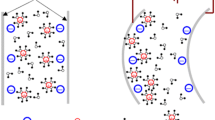Abstract
Fishes are famous for their ability to position themselves accurately even in turbulent flows. This ability is the result of the coordinated movement of fins which extend from the body. We have embarked on a research program designed to develop an agile and high efficient biologically inspired robotic fish based on the performance of hybrid mechanical fins. To accomplish this goal, a mechanical ray-like fin actuated by Shape Memory Alloy (SMA) is developed, which can realize both oscillatory locomotion and undulatory locomotion. We first give a brief introduction on the mechanical structure of our fin and then carry out theoretic analysis on force generation. Detailed information of these theoretical results is later revealed by Computational Fluid Dynamic (CFD), and is final validated by experiments. This robotic fin has potential application as a propulsor for future underwater vehicles in addition to being a valuable scientific instrument.
Similar content being viewed by others
References
Moyle P B, Cech J J. Fishes, an Introduction to Ichthology, 5th Edition, Pearson Prentice Hall, Upper Saddle River, NJ, 2004.
Sfakiotakis M, Lane D M, Davies J B C. Review of fish swimming modes for aquatic locomotion. IEEE Journal of Oceanic Engineering, 1999, 24, 237–252.
Safakcan T, Burhanettin K, Abdulkadir E. Design of a swimming mini robot. The 9th Mechatronics Forum International Conference (MECHATRONICS 2004), Ankara, Turkey, 2004.
How Ships’ Traffic Noise Affects Whales in a Shipping Channel, [2003-05], http://www.pbs.org/odyssey/odyssey/20030506_log_transcript.html
Low K H. Biomimetic motion planning of an undulating robotic fish fin. Journal of Vibration and Control, 2006, 12, 1337–1359.
Han S S, Choi S B, Kim J H. Position control of a flexible gantry robot arm using smart material actuators. Journal of Robot Systems, 1999, 16, 581–595.
Choi S B. Position control of a single-link mechanism activated by shape memory alloy springs: Experimental results. Smart Maters and Structures, 2006, 15, 51–58.
Selden B, Cho K, Asada H H. Segmented shape memory alloy actuators using hysteresis loop control. Smart Maters and Structures, 2006, 15, 642–652.
Zhang Y H, Song Y, Yang J. Analysis and testing of shape memory alloy driven biorobotic fish fins with multi propulsion modes. Smart Materials and Smart Structures Technology (SMSST07), Nanjing, China, 2007.
Zhang Y H, He J H, Zhang S W, Yang J. Underwater deformation precision analysis of shape memory alloy actuators used in biomimetic fish fin. Robot, 2007, 29, 320–325. (in Chinese)
Zhang Y H, He J H, Zhang S W, Dong E B, Yang J. Research on biomimetic fish fin driven by NiTi shape memory alloy. Robot, 2007, 29, 207–213. (in Chinese)
Zhang Y H, He J H, Yang J, Zhang S W, Low K H. A Computational Fluid Dynamics (CFD) analysis of an undulatory mechanical fin driven by shape memory alloy. International Journal of Automation and Computing, 2006, 3, 374–381.
Merzkirch W. Fluid Mechanics of Flow Metering, Springer, Berlin, Germany, 2005.
Ramamurti R, Löhner R, Sandberg W C. Computation of the 3-D unsteady flow past deforming geometries. International Journal of Computational Fluid Dynamics, 1999, 13, 83–99.
Wang Z J, Birch J M, Dickinson M H. Unsteady forces and flows in low Reynolds number hovering flight: Two-dimensional computations vs robotic wing experiments. The Journal of Experimental Biology, 2004, 207, 449–460.
Ramamurti R, Sandberg W C, Löhner R, Walker J A, Westneat M W. Fluid dynamics of flapping aquatic flight in the bird wrasse: 3-D unsteady computations with fin deformation. The Journal of Experimental Biology, 2002, 205, 2997–3008.
Ramamurti R, Sandberg W, Löhner R. The influence of fin rigidity and gusts on the force production in fishes and insects: A computational study. 42nd AIAA Aerospace Sciences Meeting and Exhibit, Reno, Nevada, 2004.
Zhao P F, Liu C Y, Zheng M Z, Wang M L. A flapping model wing experiment for insect flight investigation. The 2nd International Symposium on Aqua Bio-Mechanisms (ISABMEC), Honolulu, Hawaii, 2003, 14–17.
Zhao P F, Liu C Y, Zhu L W, Chen X Y, Yang J M. Visualization of vortex field of 2D flapping wing motion. Journal of University of Science and Technology of China, 2005, 35, 441–447. (in Chinese)
Author information
Authors and Affiliations
Corresponding author
Rights and permissions
About this article
Cite this article
Zhang, Yh., Song, Y., Yang, J. et al. Numerical and Experimental Research on Modular Oscillating Fin. J Bionic Eng 5, 13–23 (2008). https://doi.org/10.1016/S1672-6529(08)60002-5
Published:
Issue Date:
DOI: https://doi.org/10.1016/S1672-6529(08)60002-5




